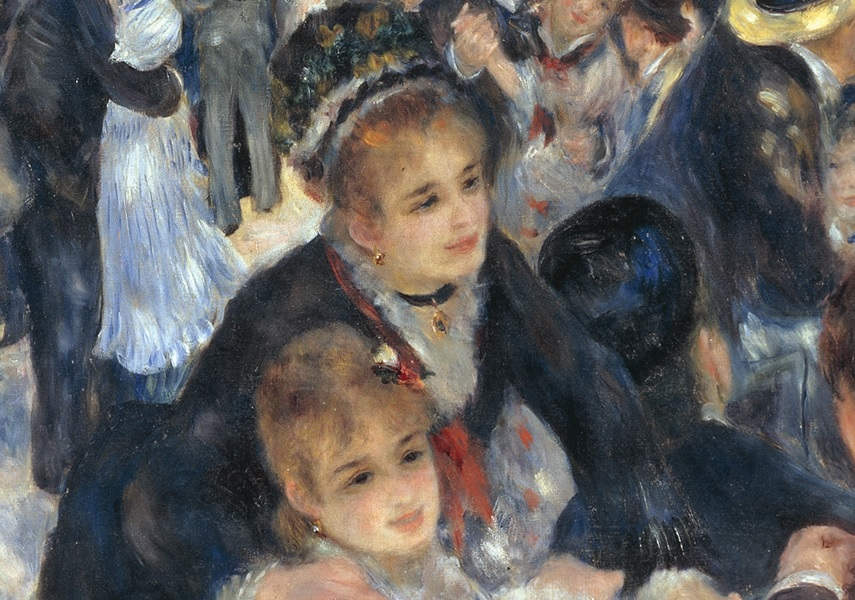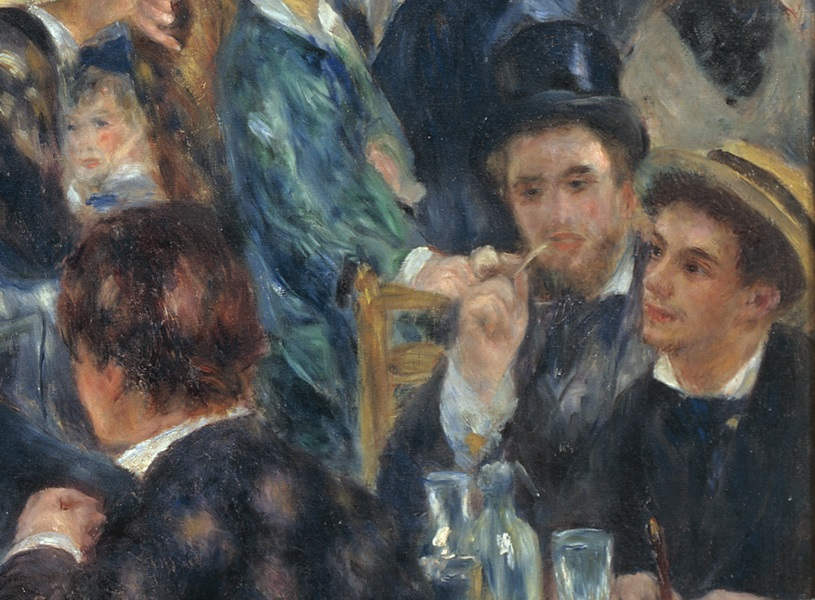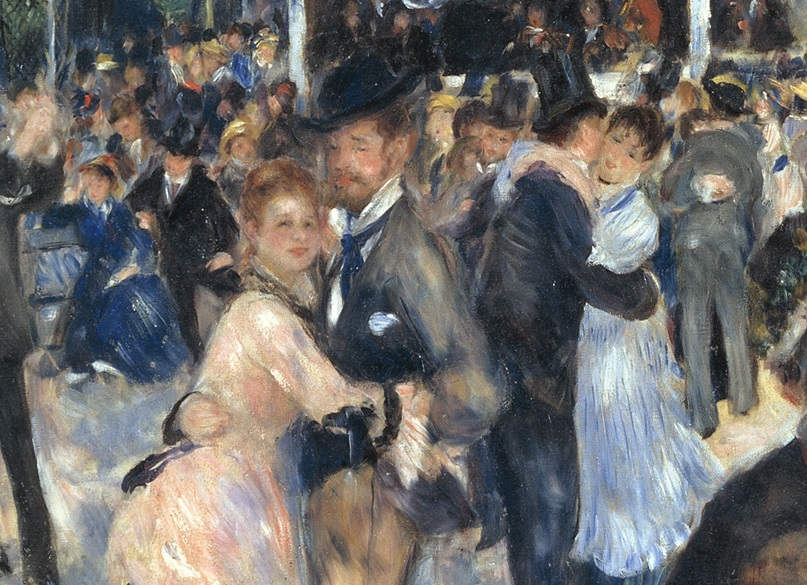Bal du Moulin de la Galette - A Dazzling Example of Renoir's Talent for Capturing Light
Paris has changed significantly during La Belle Époque. The period from the end of the 19th century until 1914 brought an architectural overhaul of the city followed by cultural shifts in other spheres, including visual arts. Pierre-Auguste Renoir and other Impressionist painters were developing a new visual language that contrasted strict academic canon, and graphic designers raised printmaking to a fine art status. Artists went to parks, streets, the seaside, and other popular gathering places in effort to capture the changing world and its inhabitants. Plein-air paintings started to appear, full of light and impatient gestures, capturing just impressions instead of providing detailed studies of their subjects.
One of such paintings is the famous Bal du Moulin de la Galette (Dance at the Moulin de la Galette) by Renoir. The painter visited the favourite weekend location for the working-class Parisians, where they would gather to dance, converse, eat galettes, and drink. He captured a snapshot of their leisure life in what is considered today a masterpiece of Impressionism and a harbinger of new social representations and style in art.

Bal du Moulin de la Galette
Pierre-Auguste Renoir painted his famous dance piece Bal du moulin de la Galette in 1876. The painting represents his mature style of rich forms and fluid brushstrokes, preceded by several studies, including a smaller piece similar to the original, which Renoir used to explore the characters, dresses, dance, and moments he would present in the final version, measuring 52 by 69 inches (132 by 175 cm).
The painting, finished just two years after the first Impressionist exhibition in Paris, shows aesthetic elements associated with the movement. Renoir depicted his figures in loose brushstrokes and vivid colors, and although some of them wear black suits, a closer observation reveals that even the darker parts were painted with several colors, instead of pure black.
Impressionists were preoccupied with the representation of light and its effect on objects, and Renoir explored this approach by painting even the darkest parts of his paintings in different hues. A smaller version of the painting reveals his tactics; the piece shows even more liberated brushwork in different tones that seemingly compose black color.

La Belle Époque and Moulin de la Galette
The location shown in the painting, Moulin de la Galette, was an outdoor dancing hall in Montmartre (a fashionable artistic district in Paris) that went through changes together with the whole city during La Belle Époque. Although La Belle Époque means the beautiful era in translation, it stared at the ruins of the previous period marked by turbulences and destruction of the city.
After the fall of the Paris Commune - a revolutionary government that emerged following France's defeat in the Franco-Prussian War and the collapse of the Second Empire - the city was severely damaged, and many of its buildings were burned down. The new government was forced to rebuild the city, which led to the creation of some of the most famous Paris landmarks, including the Eiffel Tower, the Gare d'Orsay (today Musée d'Orsay), the Petit Palais, the Grand Palais, the Palais Garnier, Art Nouveau entryways to the underground, and Sacré-Coeur.
Moulin de la Galette was initially a location of a 17th-century moulin or windmill, that was used for the milling of flour. The family that owned it, the Debrays, would bake galettes and sell them to the locals with a glass of milk or wine. During the 19th century, the location changed from a manufacturing facility into a cabaret, but the name remained.
La Belle Époque lasted from 1871 to 1914, during which almost all aspects of Parisian culture were remodeled. Novels were modernized, architects created plans for a new city, and visual artists developed new movements that would influence art practices worldwide. The transformed city propelled artists to seek new expressions for the rapidly changing time, with Renoir and other artists, including Henri de Toulouse-Lautrec, Vincent van Gogh, and Pablo Picasso, exploring new places and topics such as Moulin de la Galette.

The People of Le Moulin Painting
Although art critics and historians were primarily interested in the painting's Impressionist treatment of the subject, its content is equally fascinating and reveals a general social matrix of 19th-century Paris and the crowd gathering at Moulin de la Galette.
The information about the persons in the painting comes from Renoir's friend and art critic Georges Rivière, who described in detail the execution of the artwork in his Renoir et ses amis (Renoir and his friends) memoir, describing the artist's life and work. Renoir set a studio near the Moulin de la Galette, in an old cottage, making it easier for him to paint the local scenery.
Two girls in the foreground are believed to be Jeanne Samary and her sister Estelle, who would visit Le Moulin every Sunday. Jeanne was a French actress who performed in one of Paris' leading theatres, Comédie-Française. This was not the first Renoir's work on which she appeared, with other paintings being Le déjeuner des canotiers (Luncheon of the Boating Party) and La balançoire (The Swing). Three young men sitting next to them are Pierre-Franc Lamy, Norbert Goeneutte, and Georges Rivière. Goeneutte, famous for his illustrations, was also depicted on La balançoire with Jeanne. Lamy was a painter and engraver who also participated in the third Impressionist exhibition.
Among the dancers behind the group are Eugène Pierre Lestringuez, Henri Gervex, Paul Lhote, Don Pedro Vidal de Solares y Cárdenas, and Marguerite Legrand. Lhote also appears in the Dance in the Country painting. Cuban painter Don Pedro Vidal de Solares y Cardenas depicted in striped trousers, is dancing with Marguerite Legrand, a model also known as Margot. The book describes that she helped the Cuban painter loosen up a bit, as he was too reserved and taught him to dance polkas. She died two years later from typhoid, with Renoir being by her side and nursing her until the end.
One of the most celebrated Impressionist paintings, Bal du moulin de la Galette was sold to Renoir's friend and painter Gustave Caillebotte in 1879 and remained in his possession until his death in 1894. Afterward, the painting was exhibited at Musée du Luxembourg until 1929, at the Louvre for 57 years, and can be seen today at the Musée d'Orsay.
Featured image: Pierre-Auguste Renoir - Bal du Moulin de la Galette, 1876. Captions, via Creative Commons
Can We Help?
Have a question or a technical issue? Want to learn more about our services to art dealers? Let us know and you'll hear from us within the next 24 hours.
